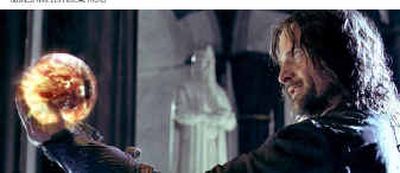Extended editions

If there was any criticism leveled at the Oscar-winning “The Lord of the Rings: The Return of the King,” it was that the movie, with its drawn-out final sequences and three-hour-plus running time, seemed to never end.
Now director Peter Jackson is making that come true.
With last month’s release of his four-hour “extended edition” on DVD, Jackson is proving that the moviemaking process can go on indefinitely.
Even if you saw all three “Lord of the Rings” movies in theaters, you’re missing two hours of added footage on DVDs of “The Fellowship of the Ring,” “The Two Towers” and “The Return of the King,” which are based on the J.R.R. Tolkien fantasy novels.
At this point, all three movies run 11 hours combined, but there’s nothing stopping Jackson from returning in 10 years and doing another version. He’d probably receive plenty of encouragement to do so, especially from the studio.
As DVD sales climb, filmmakers are ever more conscious of post-theater possibilities. Last year, more than 40 films were released in longer DVD versions, as director’s cuts, extended editions or unrated versions.
They range from George Lucas’ sci-fi debut, “THX 1138” to the Wayans brothers comedy “White Chicks,” from the crime story “True Romance” to the lewd “Badder Santa,” from the heroin-soaked “Trainspotting” to the funkadelic farce “Soul Plane.”
Instead of burning unused footage, as was infamously done with Orson Welles’ “Magnificent Ambersons” and Erich von Stroheim’s “Greed,” studios are preserving deleted scenes to provide selling points – “extras” – for DVDs.
“The basic strategy behind the marketing of any type of new DVD … is to attract the people who’ve already seen the movie,” says Mike Paxton, senior analyst at the Scottsdale, Ariz., technology-research firm In-Stat/MDR.
“I’ve already paid $8 to see ‘Spider-Man 2.’ What’s going to drive me to spend another $15 to $20 to buy the disc?”
Last summer, “Spider-Man 2” director Sam Raimi put it this way: “I think (the studio’s) thinking is, once the dad has spent the money to take the family to the movies and once the dad has bought the kid the DVD, they can still smell a few more bucks in the dad’s pocket.
“The kid’ll say, ‘Hey Dad, we’ve got to buy the new one.’ ‘Didn’t I take you to the movie and buy you the DVD already?’ ‘Yeah, but there’s a new five minutes on this one.’ “
Some director’s cuts are serious efforts, such as “The Lord of the Rings” trilogy, Francis Ford Coppola’s “Apocalypse Now,” William Friedkin’s “The Exorcist” and Ridley Scott’s “Blade Runner” and “Alien.”
With other films, directors restore scenes trimmed to make movies shorter or explicit sequences that didn’t jibe with the studio’s required rating. (“Unrated” on a DVD release is code for the sure selling point of more sex and violence.)
For the “1.5 edition” DVD of “Daredevil,” which stars Ben Affleck as a blind crime fighter, director Mark Steven Johnson restored 30 minutes cut by the studio. “The problem?” asked Entertainment Weekly. “The movie still reeks.”
Artists always have been tempted to try to improve their work. Postimpressionist painter Pierre Bonnard once entered the Louvre with brushes hidden beneath his coat, intending to retouch one of his paintings. In preventing him, a security guard noted, “Monsieur Bonnard, it’s hanging in the Louvre. It’s finished.”
Not so with Lucas and “Star Wars.” Lucas has tinkered with his groundbreaking sci-fi movies for years, creating several director’s cuts that, in his mind and in all practicality, replace the originals.
In releasing the first three movies (“Star Wars,” “The Empire Strikes Back,” “Return of the Jedi”) on DVD this year, Lucas offered only the most recent cuts, which – to fans’ chagrin – change the sequence in which Han Solo shoots the bounty hunter Greedo, to make it seem like Greedo fired first.
With the same political correctness in mind, Steven Spielberg used digital effects to turn shotguns into walkie-talkies in his director’s cut of “E.T. the Extra Terrestrial.” Unlike Lucas, however, Spielberg packaged the original version alongside the new one.
That’s an important distinction, says James Rocchi, film critic for the online DVD-rental site Netflix. Rocchi recalled when detective novelist Raymond Chandler was asked whether Hollywood had ruined his books, he pointed to a bookshelf and said, “There they all are.”
“As long as the film is originally available,” Rocchi says, “I don’t really object too much.”